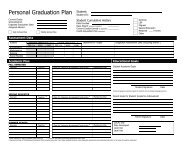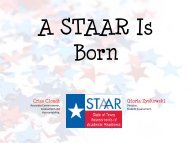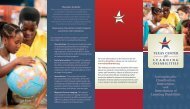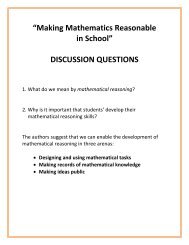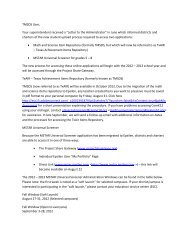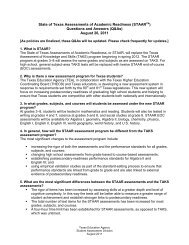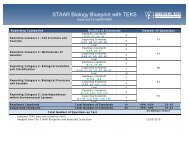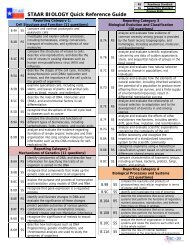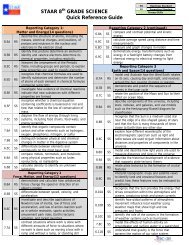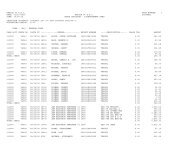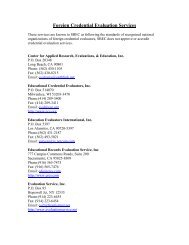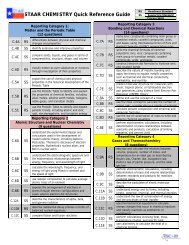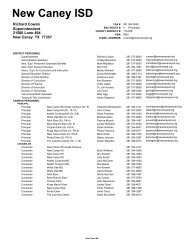STAAR PHYSICS Quick Reference Guide - Education Service ...
STAAR PHYSICS Quick Reference Guide - Education Service ...
STAAR PHYSICS Quick Reference Guide - Education Service ...
You also want an ePaper? Increase the reach of your titles
YUMPU automatically turns print PDFs into web optimized ePapers that Google loves.
Process Skills<br />
Embedded in at least 40% of the questions<br />
demonstrate safe practices during laboratory and<br />
P.1A<br />
field investigations<br />
demonstrate an understanding of the use and<br />
P.1B conservation of resources and the proper<br />
disposal or recycling of materials<br />
know the definition of science and understand<br />
P.2A that it has limitations, as specified in subsection<br />
(b)(2) of this section<br />
know that scientific hypotheses are tentative and<br />
testable statements that must be capable of<br />
being supported or not supported by<br />
P.2B observational evidence. Hypotheses of durable<br />
explanatory power which have been tested over<br />
a wide variety of conditions are incorporated into<br />
theories<br />
know that scientific theories are based on natural<br />
and physical phenomena and are capable of<br />
being tested by multiple independent<br />
researchers. Unlike hypotheses, scientific<br />
P.2C<br />
theories are well-established and highly-reliable<br />
explanations, but may be subject to change as<br />
new areas of science and new technologies are<br />
developed<br />
distinguish between scientific hypotheses and<br />
P.2D<br />
scientific theories<br />
design and implement investigative procedures,<br />
including making observations, asking welldefined<br />
questions, formulating testable<br />
P.2E<br />
hypotheses, identifying variables, selecting<br />
appropriate equipment and technology, and<br />
evaluating numerical answers for reasonableness<br />
demonstrate the use of course apparatus,<br />
equipment, techniques, and procedures,<br />
including multimeters (current, voltage,<br />
resistance), triple beam balances, batteries,<br />
clamps, dynamics demonstration equipment,<br />
collision apparatus, data acquisition probes,<br />
discharge tubes with power supply (H, He, Ne,<br />
Ar), hand-held visual spectroscopes, hot plates,<br />
slotted and hooked lab masses, bar magnets,<br />
horseshoe magnets, plane mirrors, convex<br />
lenses, pendulum support, power supply, ring<br />
clamps, ring stands, stopwatches, trajectory<br />
apparatus, tuning forks, carbon paper, graph<br />
P.2F<br />
paper, magnetic compasses, polarized film,<br />
prisms, protractors, resistors, friction blocks, mini<br />
lamps (bulbs) and sockets, electrostatics kits, 90degree<br />
rod clamps, metric rulers, spring scales,<br />
knife blade switches, Celsius thermometers,<br />
meter sticks, scientific calculators, graphing<br />
technology, computers, cathode ray tubes with<br />
horseshoe magnets, ballistic carts or equivalent,<br />
resonance tubes, spools of nylon thread or<br />
string, containers of iron filings, rolls of white<br />
craft paper, copper wire, Periodic Table,<br />
electromagnetic spectrum charts, slinky springs,<br />
wave motion ropes, and laser pointers<br />
P.2G<br />
P.2H<br />
P.2I<br />
P.2J<br />
P.2K<br />
P.2L<br />
P.3A<br />
P.3B<br />
P.3C<br />
P.3D<br />
P.3E<br />
P.3F<br />
Process Skills (continued)<br />
use a wide variety of additional course apparatus,<br />
equipment, techniques, materials, and procedures as<br />
appropriate such as ripple tank with wave generator,<br />
wave motion rope, micrometer, caliper, radiation<br />
monitor, computer, ballistic pendulum, electroscope,<br />
inclined plane, optics bench, optics kit, pulley with<br />
table clamp, resonance tube, ring stand screen, four<br />
inch ring, stroboscope, graduated cylinders, and ticker<br />
timer<br />
make measurements with accuracy and precision and<br />
record data using scientific notation and International<br />
System (SI) units<br />
identify and quantify causes and effects of<br />
uncertainties in measured data<br />
organize and evaluate data and make inferences from<br />
data, including the use of tables, charts, and graphs<br />
communicate valid conclusions supported by the data<br />
through various methods such as lab reports, labeled<br />
drawings, graphic organizers, journals, summaries, oral<br />
reports, and technology-based reports<br />
express and manipulate relationships among physical<br />
variables quantitatively, including the use of graphs,<br />
charts, and equations<br />
in all fields of science, analyze, evaluate, and critique<br />
scientific explanations by using empirical evidence,<br />
logical reasoning, and experimental and observational<br />
testing, including examining all sides of scientific<br />
evidence of those scientific explanations, so as to<br />
encourage critical thinking by the student<br />
communicate and apply scientific information extracted<br />
from various sources such as current events, news<br />
reports, published journal articles, and marketing<br />
materials<br />
draw inferences based on data related to promotional<br />
materials for products and services<br />
explain the impacts of the scientific contributions of a<br />
variety of historical and contemporary scientists on<br />
scientific thought and society<br />
research and describe the connections between physics<br />
and future careers<br />
express and interpret relationships symbolically in<br />
accordance with accepted theories to make predictions<br />
and solve problems mathematically, including problems<br />
requiring proportional reasoning and graphical vector<br />
addition<br />
Readiness<br />
Standards<br />
Supporting<br />
Standards<br />
Number of<br />
Standards<br />
Number of Questions<br />
12 60 – 65% 30 – 33<br />
19 35 – 40% 17 – 20<br />
45 Multiple Choice and 5 Griddable



